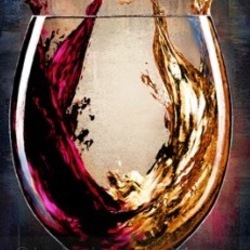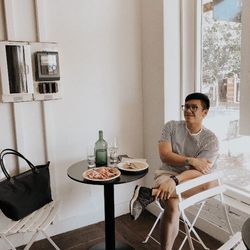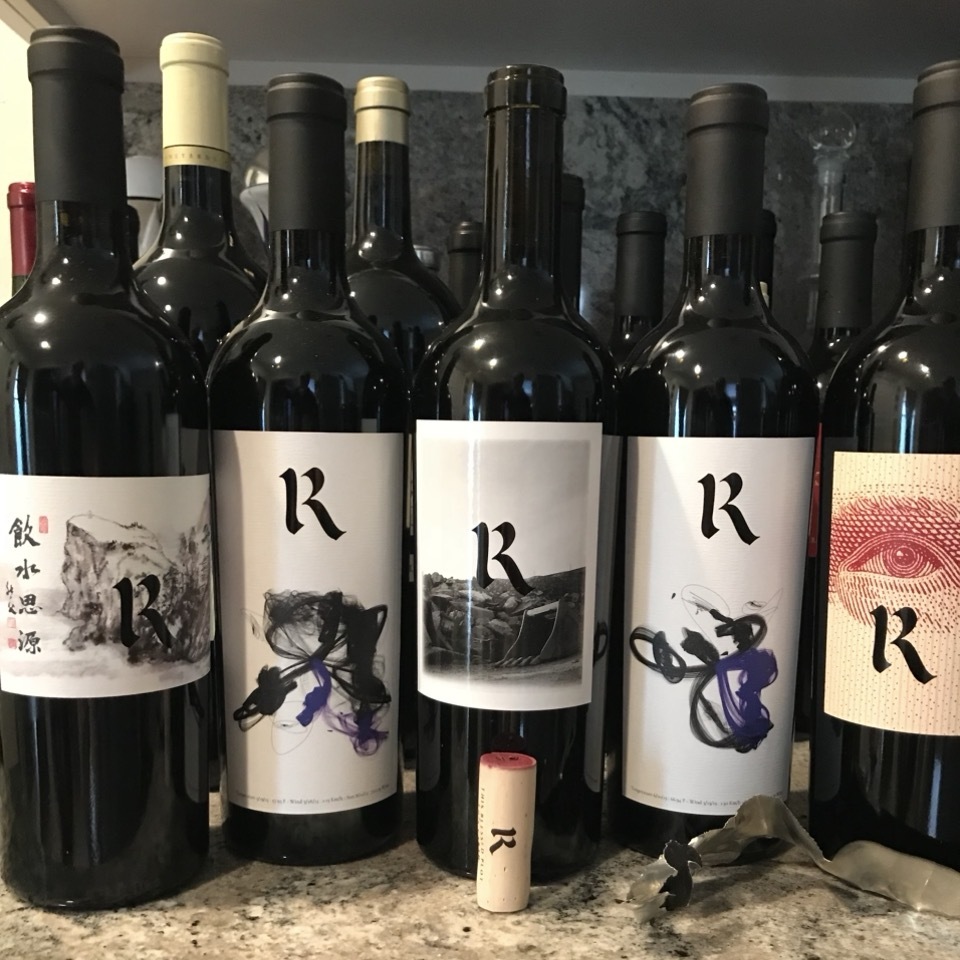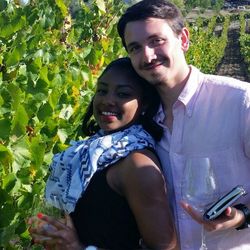Teuta (queen Of Wines)
Azienda Agricola Brovia
Villero Barolo Nebbiolo 2013
Fascinating how different this is from the Rocche 13' (from the same producer). Goes to show that Piedmont is indeed a great distraction from Burgundy, which has been reflected in the increasing prices. Thankfully, Brovia's wines are still "under the radar." Affordable, in the scale of things.
Neighbouring vineyards. The Rocche - blue-fruit focused, leaner, less tannic on the palate (but you could smell it), elegant if not firmer. The Villero - red-fruited, more classic on the nose, brawny palate, with big spice tones and a blood-like minerality. No preference of one over the other at the moment. Rocche, the queen of Brovia's line-up, and Villero, the king! Their purity, nuance, and turbo-charged aromatics are seriously impressive, though it doesn't make it any easier to drink them at this early stage. Definitely cellar these crus. Minimum 20 years! — 6 years ago
Bollinger
Brut Rosé Champagne Blend
On the nose; bright cherries, ripe strawberry & cranberry reduction, black raspberries, raspberries, watermelon near the rhine, mixed orange citrus, oyster shells, baguette crust, understated volcanic minerals, chalk, saline, fresh pink roses and florals. The body is full and a shade gluey. The fruits are ripe, rich and candied/gummy in style. Bright cherries, black cherries ripe strawberry & cranberry reduction, black raspberries, raspberries, watermelon near the rhine, mixed orange citrus spray, saline, seashells, soft grey volcanic minerals, lots of grippy powdery razor sharp chalkiness, baguette crust, fresh pink roses & florals, acidity that is round and well done, understated delicate micro bubbles and a long, well balanced, rich finish. The reason why I prefer the Billecart Salmon, Ruinart & Laurent Perrier over the Bollinger is it’s a little too sweet for me. Photos of; the House of Bollinger, cellar, headstone that marks one of their vineyards and their harvest staff picking perfectly manicured rows. Producer notes and history...Bollinger has roots dating back to 1585 when the Hennequins, one of the Bollinger founding families, owned land in Cramant. Before the Bollinger house was founded in the 18th century, the Villermont family practised wine making, though not under their family name. In 1750, Villermont settled at 16 rue Jules Lobet, which would eventually become the head office for Bollinger. In 1803 Jacques Joseph Placide Bollinger was born in Ellwangen, in the kingdom of Württemberg. In 1822, he moved to Champagne and found work at the house of Muller Ruinart, which no longer exists. Many other Germans came to settle in the Champagne region, including Johann-Josef Krug and the Heidsiecks, who founded a house that would become; Charles Heidsieck, Piper Heidsieck, Veuve Clicquot and others. The Champagne house Renaudin Bollinger was founded in 1829 in Aÿ by Hennequin de Villermont, Paul Levieux Renaudin and Jacques Bollinger. The partners agreed that the Villermont name would not be used on the labels, hence the house name Renaudin Bollinger. Starting when Jacques Bollinger married Charlotte de Villermont, the house has been managed by the Bollinger family. Even though Paul Renaudin passed without an heir to his name, the label did not become solely Bollinger until the 1960s. Founder Jacques Joseph Bollinger married Charlotte de Villermont. The had a daughter, who had two sons Joseph and Georges. These sons took over the company in 1885 and began expanding the family estate by purchasing vineyards in nearby villages. The sons also developed the image of the brand, such as when Bollinger became the official supplier to the British court and received a Royal Warrant in 1884 from Queen Victoria. In 1918, Jacques Bollinger, the son of Georges, took over the company and married Emily Law de Lauriston Boubers, known as "Lily". Jacques expanded the facilities by building new cellars, purchasing the Tauxières vineyards, and acquiring the assets of another Champagne house on Boulevard du Maréchal de Lattre de Tassign, where Bollinger's offices are presently located. When Jacques Bollinger died in 1941, Lily Bollinger took over. Lilly expanded production with the purchase of even more vineyards, but is best known for traveling the world to market the brand. Bollinger was modernized under the Claude d'Hautefeuille, who acquired additional vineyards and further developed the brand internationally. Following Claude, his cousin Christian Bizot took over the Bollinger house and expanded world distribution. Their Winemaker also used several James Bond film movies to market the brand. Bollinger is fermented in oak barrels. At harvest, only the first pressing is used in the cuvée, unless the vintage is of particularly high quality, when a second pressing of Chardonnay will be used. Bollinger sells the second pressing, the tailles. Bollinger utilizes two pressing houses (Louvois and Mareuil sur Aÿ) to ensure a short distance between harvest location and pressing. When possible, grapes purchased from growers are pressed by the house. When the pressed wine arrives, the Bollinger cellar master analyzes the musts for quality, discarding and selling off those that do not meet the house standards. The first fermentation is done cru by cru, variety by variety, preserving many of the unique characteristics of the vines location. Bollinger is one of the few Champagne houses to do some first fermentation in oak barrels. Wines that will not hold up to first fermentation in wood are vinified in vats. Bollinger Champagnes usually undergo malolactic fermentation. The Grande Année 1995 did not undergo malolactic fermentation. Bollinger uses only traditional yeast. They’ve decided that new generations of yeasts (agglomerated yeasts and encapsulated yeasts) do not produce satisfactory Champagne. Vintage wine, including all wine to be used in a Grande Année, is fermented in small oak barrels, sorted according to origin and variety. Both oak and stainless steel are used for non-vintage wine. Bollinger also has the last Cooperage in Champagne. The oak barrels are all at least four years old, avoiding the transfer of tannins to the wine. The wines are only lightly filtered. All Bollinger Champagne spends a long time on its lees, contributing to the complex flavour of the wine. Though appellation d'origine contrôlée rules only require 12 months on lees for non-vintage Champagne and for vintage (NV wines, 15 months from tirage to release and vintage wines must be kept for 36 months from tirage to release), Bollinger ages their non-vintage wines three years, and the vintage wines from five to eight years. The Grande Année and R.D. Champagnes are riddled by hand. At disgorgement, Bollinger wines are given a low dosage, to maintain the balance and flavor of the wine. The company uses 6-9 grams of sugar per liter for the Special Cuvée and La Grande Année. The extra-brut R.D. is dosed between 4 and 5 grams. After dosage, the wines are aged an additional several months, resting for a minimum of three months before shipping. Bollinger owns nearly 160 hectares of vines, producing more than 60% of its supply. The vines are largely Pinot Noir, specifically clone 386. Bollinger believes this clone ensures good quality as well as highlighting characteristics of the various terroirs. The vineyards also include some rare ungrafted French vines from before the phylloxera. Bollinger owns vines all over Champagne, including the crus of Aÿ, Bouzy and Verzenay. — 8 years ago

I figured a real keyboard needed to be involved, thanks for the insight.

Bergström Wines
Old Stones Willamette Valley Chardonnay 2011
Bergstrom is my Chard Queen of this valley. #sorrynotsorry #doesthatevenmakesense. Anyway. This wine is fantastic. — 11 years ago
Domaine Leroy
Bourgogne Chardonnay 2015
The nose reveals; green apple, candle wax, lime candy, pineapple, tropical melons, cream, some buttered popcorn, white peach, honeycomb, dry & fresh herbs, soft, powdery chalkiness, saline, limestone minerals, volcanics, sea fossils, steeliness, vanillin, lanolin, cheese rind with yellow lilies/flowers, jasmine and fruit blossoms.
The mouthfeel is; full, round, lush and gorgeous with high viscosity. Green apple, candle wax, lime candy, very ripe, juicy pineapple flesh, kiwi, tropical melons, cream, some buttered popcorn, white peach, honeysuckle to honey, caramel notes, dry & fresh herbs, soft, powdery chalkiness, saline, hints of dry grass, grippy limestone minerals & grey volcanics, sea fossils, white spice, steeliness, vanillin, lanolin, cheese rind with yellow lilies/flowers, jasmine and fruit blossoms. The acidity is lively and round. The finish is minutes, nicely balanced in fruit & minerality, palate penetrating white spice with some mid intensity heat.
Gets better and better as it warms and opens up.
Photos of; Lalou Bize-Leroy (aka “The Queen of Burgundy”) tending & singing to her vines, one of their amazing vineyards and their 2015 wines aging barrel. — 5 years ago

Mountain Queen
In The Hall of the Mountain Red Mountain Blend 2013
Perfect way to start of #WAWINEMONTH with this bottle from Full Pull Wines. Deep ruby red in appearance. Dark spices on the nose with candied blackcherries, cinnamon, and a little herbal. Seems to have closed down a bit since last time. Medium plus tannins (7/10) and full bodied. Dry on the palate with black currants, cassis, sweet spices and dried herbs. Long and lingering finish. Drink till 2027. (91+) — 8 years ago
Domaine Leroy
Bourgogne Pinot Noir 2000
Nose of; sweet & sour dark cherries, some fruit liqueur and alcohol notes, macerated; blackberries, blackberries, blueberries, black plum, plum & strawberries. Cinnamon, vanilla, sweet, rich, moist, dark earth, very light spice, some black licorice, crushed dry powdery limestone, fresh & dry dark red florals, red roses and violets. The palate is full medium and gorgeously round. The tannins still have some teeth. It’s a good time to have our last 2000 of this wine. Ripe, sweet & sour; black cherries, blackberries, strawberries, black plum, plum, blue fruit notes, touch of prune, & black raspberries. Light cinnamon & vanilla, sweet, rich, moist, dark earth, very light spice, some black licorice, fruit liqueur notes, black tea, crushed dry limestone, soft volcanic minerals with an edge as they set, some bramble, fresh & dry dark red florals, red roses and violets. The acidity is like Niagara. The structure, tension, balance and length is rock solid. The finish is; long, elegant and beautiful. The thing I like about the Domaine Leroy Village wines is that they basically make it very similarly to their wines that cost in excess of $800-$1500 upon release. However, their Village wine is around $50 if you buy it right. The difference in their village wines are the vineyard sites, but once the fruit gets to the Domaine, the grapes are handled in a very similar fashion. All sites separately fermented. Great wine and even better value. Lalou Bize-Leroy (mid right photo) still owns 25% of DRC. Lalou was once also the managing Director of DRC as well. She stepped aside over differences of opinion regarding yields and being completely biodynamic. Lalou prefers very low yields. Domaine Leroy is completely biodynamic. Lalou Bize-Leroy also has her own vine training method and all pruning is done strictly by hand. Additionally, she believes in the benefits of singing to her vines (her babies) daily. Lalou Bize-Leroy is and will forever be a legend in Burgundy as she has been deemed “The Queen of Burgundy!” — 8 years ago

Arianna Occhipinti
Siccagno Nero d'Avola 2012
Arianna Occhipinti Nero d'Avola 'Siccagno' 2012
The Queen of Sicilian wine, Occhipinti wines reflect their place as well as transcend place, taking the wines to a level of superstardom as far as the best wines of the world go.
This is an elegant and silky Nero d'Avola, with fine and ripe tannin that support a medium body wine showing fresh and bright red and blue fruits, florals, earth and minerality, finishes with an echo of acidity and those fine tannin trailing.
@ariannaocchipinti #sicily — 9 years ago
Hall Wines
Jack's Masterpiece Napa Valley Cabernet Sauvignon 2006
2006 Vintage - huge cab with big fruit! Still very tannic out of the bottle but softens nicely as it has air. A beautiful wine from the Queen of Cabs, Kathryn Hall! — 10 years ago
Queen of Hearts Wines
Santa Barbara County Pinot Noir 2012
Light bodied, cherry fruit - live it!! — 12 years ago
Bruliam Wines
Bu Rocky Ridge Vineyard Zinfandel 2017
Okay. First of all, this is Gap’s Crown Vineyard 2017 pinot noir in SONOMA baby! Kerith is absolutely amazing. She has developed and crafted a wine so beautiful, its worthy to be the house wine for the Royal Palace and the Queen of England! Nevertheless, it is definitely my house Pinot Noir as well as the best Pinot Noir you will ever have. Before I discovered Bruliam wines, I thought the best pinots came from Oregon. Boy was I wrong! Kerith.... wow. Excellent job. And that’s really all I have to say if you like Pinot Noir, you’re going to love Bruliam- wine is elemental! Just do it! — 5 years ago


Day Wines
Queen D Applegate Valley White Blend 2016
32/23/23/22 blend of Vermentino, Marsanne, Rousanne and Grenache Blanc. Pale white, excellent clarity. Floral and stone fruit notes in nose. Lemon, lime, tangerine pith and stone fruit flavors, lime and mineral in finish, almost dry, robust level of acidity with a variety of acids - tartaric, citric, malic. Slight carbonation in the mouth - tactile-wise, not visually. Good food wine but Vermentino character makes it suitable as an aperitif. Grenache Blanc gives it a moderate skin astringency on finish along with an herbal (dill) and slight white pepper aftertaste. Overnight, a ripe black plum skin flavor emerges in the finish, accompanied by a tart, slightly chalky flavor, maybe from lees contact. Complex flavor profile; the varietal blend and proportions largely work here. Fun wine but still easy to drink despite the apparent complexity of its components. Creative but successful wine craft overall. — 6 years ago
Caves Emile Cheysson
Le Bistrot de la Mère Maréchal Les côteaux du Lyonnais Chardonnay 2015
Crazy good right-time-of-the-year-for-no-wood French Chardonnay, herbal and melon from nose to finish showing plenty of acid/tannic softly clinging depth front to back (even without wood), hints of some cantaloupe towards the end and a tinge of fresh raw celery throughout the drink. This wine was brilliantly paired with a groovy tart greens-based salad, at my buddy, Geoph Adams', waterfront Black Sheep, in Beaufort, NC. Don't miss his magic moment when hanging or passing through NC's middle cape, which is Lookout (Beaufort being lazy, crazy, cool). Another brilliant wine by Eric and Laure's Queen of Wines (boutique importing and distribution bringing the passion of France straight into NC) so cool!!! — 3 hours ago — 8 years ago
Azienda Agricola Le Ragnaie
Fornace Brunello di Montalcino Sangiovese
Better than Priscilla queen of the dessert . Power and depth with incredible refinement. Darker and deeper than I'd usually expect. wines have a herbaciousness that I find compelling. — 8 years ago
Leah Jørgensen Cellars
Les Collines Cabernet Franc
This is the second bottle I've tasted from Leah Jørgensen, on finishing my glass, I can honestly say her wines leave me with more questions than answers. The 2014 Tour Rain reminds me of some of my favorite wines from the Bourgueil. With a brilliant dark magenta robe, this Oregon Cab Franc is seductive and multifaceted. Dusky plums and Queen Anne's cherries are couched in layers of dried rose petals, pomander ball, cinnamon bark and brown spice. It's medium-bodied, beautifully balanced and concise. Tart cherries, sweet tobacco, warm wicker. All of which leads me to wonder, who is this young winemaker? She's definitely one to watch in Oregon's evolving wine scene. 13.4% ABV | Sample — 9 years ago
Blizzard Wines
Carménère 2014
A little heat on the nose, but African violets, raspberries and juicy-ripe blackberries, cherry cola, and blueberry pie with hints of fresh mushrooms, cedar, and eucalyptus comes through. Surprisingly light in the body and tannic structure in spite of other clues - it opens with fresh, ripe Queen Anne cherries and July strawberries, immediately giving way to prunes, pot roast and crimini mushrooms, and finishing with anise, green peppers, bitter cocoa. Would be perfect with a molè. — 9 years ago
Château de Trinquevedel
Tavel Grenache Rosé 2013
Continuing with my exploration of rosé wines, is this charming not so pink from Château de Trinquevedel, a cranberry-hued blend of 56% Grenache, 20% Cinsault, 10% Clairette, 4% Syrah, 4% Bourboulenc, 3% Mourvedre and 3% Brenache blanc. Enchanting aromas of linen and dried cherries lead into a wine that displays tons of rhubarb and spice, followed by Queen Anne’s Cherries, blood oranges, and watermelon rind with subtle earthiness and smoke on the finish. Always a favorite from Kermit Lynch. 13.5% ABV — 10 years ago










Adriana Fabbro
The fact that Clarksburg Chenin Blanc is now available in a gorgeous millennial chic ombré can (featuring the skyline of sac) brings me great joy. Made by Colleen Sullivan, the young queen of Clarksburg Chenin Blanc. Honeycomb, beeswax, preserved lemon. More expressive after it warms up a bit (vs refrigerator temp). — 5 years ago